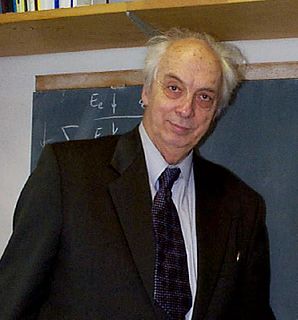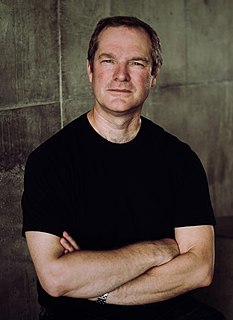
William Nelson Joy is an American computer engineer and venture capitalist. He co-founded Sun Microsystems in 1982 along with Scott McNealy, Vinod Khosla, and Andy Bechtolsheim, and served as Chief Scientist and CTO at the company until 2003.

Kim Eric Drexler is an American engineer best known for studies of the potential of molecular nanotechnology (MNT), from the 1970s and 1980s. His 1991 doctoral thesis at Massachusetts Institute of Technology was revised and published as the book Nanosystems: Molecular Machinery Manufacturing and Computation (1992), which received the Association of American Publishers award for Best Computer Science Book of 1992.

Molecular nanotechnology (MNT) is a technology based on the ability to build structures to complex, atomic specifications by means of mechanosynthesis. This is distinct from nanoscale materials. Based on Richard Feynman's vision of miniature factories using nanomachines to build complex products, this advanced form of nanotechnology would make use of positionally-controlled mechanosynthesis guided by molecular machine systems. MNT would involve combining physical principles demonstrated by biophysics, chemistry, other nanotechnologies, and the molecular machinery of life with the systems engineering principles found in modern macroscale factories.
Gray goo is a hypothetical global catastrophic scenario involving molecular nanotechnology in which out-of-control self-replicating machines consume all biomass on Earth while building more of themselves, a scenario that has been called ecophagy. The original idea assumed machines were designed to have this capability, while popularizations have assumed that machines might somehow gain this capability by accident.

A molecular assembler, as defined by K. Eric Drexler, is a "proposed device able to guide chemical reactions by positioning reactive molecules with atomic precision". A molecular assembler is a kind of molecular machine. Some biological molecules such as ribosomes fit this definition. This is because they receive instructions from messenger RNA and then assemble specific sequences of amino acids to construct protein molecules. However, the term "molecular assembler" usually refers to theoretical human-made devices.

Nanoid robotics, or for short, nanorobotics or nanobotics, is an emerging technology field creating machines or robots whose components are at or near the scale of a nanometer. More specifically, nanorobotics refers to the nanotechnology engineering discipline of designing and building nanorobots with devices ranging in size from 0.1 to 10 micrometres and constructed of nanoscale or molecular components. The terms nanobot, nanoid, nanite, nanomachine and nanomite have also been used to describe such devices currently under research and development.

Victor Georgievich Veselago was a Soviet/Russian physicist, doctor of physical and mathematical sciences, and a university professor. In 1967, he was the first to publish a theoretical analysis of materials with negative permittivity, ε, and permeability, μ.

D. P. Agrawal is a historian of Indian science and technology, archaeologist, and author. He has published works on Indian archaeology, metallurgy, the history of science, and palaeoclimate.

Paul Dourish is a computer scientist best known for his work and research at the intersection of computer science and social science. Born in Scotland, he holds the Steckler Endowed Chair of Information and Computer Science at the University of California, Irvine, where he joined the faculty in 2000, and where he directs the Steckler Center for Responsible, Ethical, and Accessible Technology. He is a Fellow of the AAAS, the ACM, and the British Computer Society, and is a two-time winner of the ACM CSCW "Lasting Impact" award, in 2016 and 2021.
The history of nanotechnology traces the development of the concepts and experimental work falling under the broad category of nanotechnology. Although nanotechnology is a relatively recent development in scientific research, the development of its central concepts happened over a longer period of time. The emergence of nanotechnology in the 1980s was caused by the convergence of experimental advances such as the invention of the scanning tunneling microscope in 1981 and the discovery of fullerenes in 1985, with the elucidation and popularization of a conceptual framework for the goals of nanotechnology beginning with the 1986 publication of the book Engines of Creation. The field was subject to growing public awareness and controversy in the early 2000s, with prominent debates about both its potential implications as well as the feasibility of the applications envisioned by advocates of molecular nanotechnology, and with governments moving to promote and fund research into nanotechnology. The early 2000s also saw the beginnings of commercial applications of nanotechnology, although these were limited to bulk applications of nanomaterials rather than the transformative applications envisioned by the field.

William Sims Bainbridge is an American sociologist who currently resides in Virginia. He is co-director of Cyber-Human Systems at the National Science Foundation (NSF). He is the first Senior Fellow to be appointed by the Institute for Ethics and Emerging Technologies. Bainbridge is most well known for his work on the sociology of religion. Recently he has published work studying the sociology of video gaming.
Michael S. Tomczyk is best known for his role in guiding the development and launch of the first microcomputer to sell one million units, as Product Manager of the Commodore VIC-20. His contributions are described in detail in his 1984 book, THE HOME COMPUTER WARS: An Insider's True Account of Commodore and Jack Tramiel. His role is also documented extensively in numerous interviews and articles. The VIC-20 was the first affordable, full-featured color computer and the first home computer to be sold in KMart and other mass market outlets. Michael joined Commodore in April 1980 as Assistant to the President. He has been called the "marketing father" of the home computer. Michael was also a pioneer in telecomputing, as co-designer of the Commodore VICModem, which he conceived and contracted while at Commodore. The VICModem was the first modem priced under $100 and the first modem to sell one million units.

Nikos Angelos Salingaros is a mathematician and polymath known for his work on urban theory, architectural theory, complexity theory, and design philosophy. He has been a close collaborator of the architect Christopher Alexander, with whom Salingaros shares a harsh critical analysis of conventional modern architecture. Like Alexander, Salingaros has proposed an alternative theoretical approach to architecture and urbanism that is more adaptive to human needs and aspirations, and that combines rigorous scientific analysis with deep intuitive experience.
The following outline is provided as an overview of and topical guide to nanotechnology:
Christopher Freeman a British economist, recognised as one of the founders of the post-war school of Innovation Studies. He played a lead role in the development of the neo-Schumpeterian tradition focusing on the crucial role of innovation for economic development and of scientific and technological activities for well-being.
The societal impact of nanotechnology are the potential benefits and challenges that the introduction of novel nanotechnological devices and materials may hold for society and human interaction. The term is sometimes expanded to also include nanotechnology's health and environmental impact, but this article will only consider the social and political impact of nanotechnology.
John Peter Oleson is a Canadian classical archaeologist and historian of ancient technology. His main interests are the Roman Near East, maritime archaeology, and ancient technology, especially hydraulic technology, water-lifting devices, and Roman concrete construction.

Rashid Bashir is Dean of The Grainger College of Engineering, Grainger Distinguished Chair in Engineering and Professor of Bioengineering, at the University of Illinois at Urbana-Champaign. He was the Executive Associate Dean and Chief Diversity Officer at the Carle-Illinois College of Medicine at UIUC. Previously, he was the Abel Bliss Professor of Engineering, Head of Department of Bioengineering, Director of the Micro and Nanotechnology Laboratory, and Co-Director of the campus-wide Center for Nanoscale Science and Technology, a "collaboratory" aimed at facilitating center grants and large initiatives around campus in the area of nanotechnology. Prior to joining UIUC, he was at Purdue University from 1998–2007 with faculty appointments in Electrical and Computer Engineering, and Bioengineering. From 1992 to 1998 he worked at National Semiconductor Corporation in Santa Clara, CA as Sr. Engineering Manager. He graduated with a PhD in Electrical Engineering from Purdue University in 1992. He has authored or co-authored over 240 journal papers, over 200 conference papers and conference abstracts, and over 120 invited talks, and has been granted 50 patents. He is an NSF Faculty Early Career Award winner and the 2012 IEEE EMBS Technical Achievement Award. He received the Pritzker Lecture Award from BMES in 2018. He is a fellow of IEEE, AIMBE, AAAS, BMES, RSC, APS, and NAI.
Vladimir Petrovich Torchilin is a Soviet, Russian and American biochemist, pharmacologist, and an expert in medical nanotechnology. Torchillin is a University Distinguished Professor of Pharmaceutical Sciences at Northeastern University. He also serves as a Director at both the Center for Translational Cancer Nanomedicine and at the Center for Pharmaceutical Biotechnology and Nanomedicine at Northeastern University.

Andrew David Maynard is an author, professor, and director of the Risk Innovation Lab at the School for the Future of Innovation in Society (SFIS) at Arizona State University (ASU). Maynard was previously the director of the University of Michigan Risk Science Center and served as Science Advisor to the Project on Emerging Nanotechnologies at the Woodrow Wilson International Center for Scholars. His work focuses on the socially responsive and responsible development of emerging and converging technologies.










